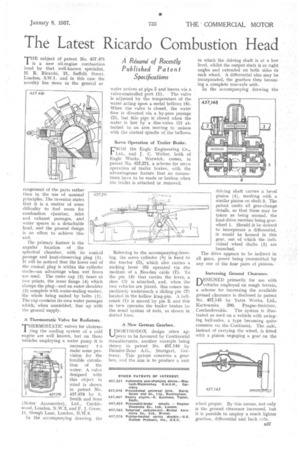The Latest Ricardo Combustion Head
Page 51

If you've noticed an error in this article please click here to report it so we can fix it.
THE subject of patent No. 457.4E4 is a new oil-engine combustion head by that well-known specialist, H. R. Ricardo, 21, Suffolk Street, London, S.W.1, and in this case the novelty lies more in the general ar
rangement of the parts rather than in the use of unusual principles. The inventor states that it is a matter of some difficulty to find room for combustion chamber, inlet and exhaust passages, and water spaces in a detachable head, and the present design, is an 'effort to achieve this end. • The primary feature is the angular location of the
spherical chamber, with its conical passage and heat-c6nserving plug (5). It will be noticed that the lower end of the conical plug is within the cylinder circle—an advantage When wet liners are used. The outer cap (2) bears at two points, the inner flange (4) which clamps the plug—and an outer shoulder (3) complete with water-sealing washer, the whole being united by bolts (I). The cap contains its own water passages which, when assembled; line up with the general supply.
A Thermostatic 'Valve for Radiators.
TTHERMOSTATIC valves for obstrue/ ting the cooling system. of a cold engine are well known-, but on those vehicles employing a water pump it is
necessary t o make some provision for the forcible circulation of the water: A valve designed with this object in mind is shown in patent No.
457;o78 457,078 by S. Smith and Sons (Motor Accessories), Ltd., Cricklewood, London, N.W.2, and F. J. Grose, II, Slough Lane, London, N.W.9. In the accompanying drawing, the water arrives at pipe 5 and leaves via a valve-controlled port (1). -• The valve is adjusted by the temperature of the water acting upon a metal bellows (4). When the valve is closed, the water flow is diverted via a by-pass passage (2), but this pipe is closed when the water is hot by a disc-valve (3) attached to an arm moving in unison with the central ipindle of the bellows.
Servo Operation of Trailer Brake.
FRON( the Eagle Engineering Co., Ltd., and J. C. Walter, both of Eagle Works,Warwick, comes, in patent No. 457,271, a scheme for servo operation of trailer brakes, with the advantageous feature that no connections have to be made or broken when the trailer is attached br removed.
Referring to the accompanying drawing, the servo cylinder (8) is flied to the tractor (5), which also carries, a rocking lever (6) operated via the medium of a .Bowden cable (7). To the pin (4) that carries the lever, a shoe (3) is attached, and, when the two vehicles are joined, this comes immediately underneath a sliding pin (2) located in the hollow king-pin. A bellcrank (1) is moved by pin 2, and this in turn operates the trailer brakes by the usual system of rods, as shown in dotted lines. .
A New German Gearbox.
U1NORTHODOX design often apk-)pears to be favoured by Continental manufacturers, another example being shown in patent No. 457,148 by Daimler-Benz A.G., Stuttgart, Germany. This patent conceals a gearbox, and the aim is to produce a unit in which the driving shaft is at a low level, whilst the output shaft is at right angles and extended on both sides to each wheel. A differential also may be incorporated, the gearbox then becom ing a complete rear-axle unit. In the accompanying drawing the
driving shaft carries a bevel pinion (4), meshing with a similar pinion on shaft 3. The patent omits all gear-change details, so that these may he taken as being normal, the final-drive member being gearwheel 1. Should it be desired to incorporate a differential, it would be housed in this gear, out of which the individual wheel shafts (2) are branched.'
The drive appears to be indirect in all gears, power being transmitted by any one of the four pairs of pinions.
Increasing Ground Clearance.
DESIGNED primarily for use with L./vehicles employed on rough terrain, a scheme for increasing the available ground clearance is disclosed in patent No. 40;145 by Tatra Works, Ltd., Kartouzska 260, Prague-Smichov, Czechoslovakia. The system is illustrated as used on a vehicle with swinging half-axles, a type becoming quite common on the Continent. The axle, instead of carrying the wheel, is fitted with a pinion engaging a gear on the




























































































